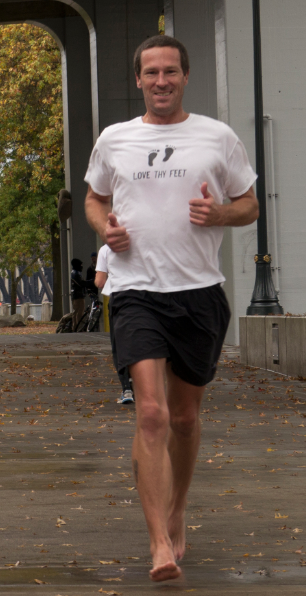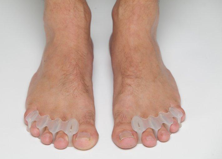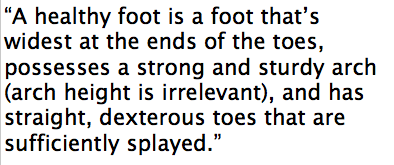 Portland, Oregon-based Podiatrist Dr. Ray McClanahan is a rarity in his profession. He considers conventional treatment such as orthotics and surgery as a final-resort option for his patients. Instead, he favors a more natural, non-invasive approach that, as he states in the following interview with the Natural Running Center, “respects the inherent strength and integrity of the human foot”. Dr. Ray McClanahan is the creator of the toe-spacing device known as Correct Toes, and is also a Health and Medical Advisor to the NRC.
Portland, Oregon-based Podiatrist Dr. Ray McClanahan is a rarity in his profession. He considers conventional treatment such as orthotics and surgery as a final-resort option for his patients. Instead, he favors a more natural, non-invasive approach that, as he states in the following interview with the Natural Running Center, “respects the inherent strength and integrity of the human foot”. Dr. Ray McClanahan is the creator of the toe-spacing device known as Correct Toes, and is also a Health and Medical Advisor to the NRC.
Q:What is your athletic background, and how did this influence your decision to enter the podiatric profession?
Dr. Ray McClanahan: Running is one of the greatest passions of my life. I ran competitively at a fairly elite level for many years before, during, and after college and podiatry school. I still love to run every day, though I’m not racing as much these days as I used to. A few personal running career highlights: In 1999, I finished fourteenth in the U.S. National Men’s Cross-Country Championships, and in 2000, I narrowly missed qualifying for the Olympic Trials 5,000-meter event with a time of 13:56. I had the great fortune of qualifying for the World Duathlon Championships in 2001. These were all great moments for me in my athletic career, but I just really love to run, competitively or recreationally. It’s a big part of who I am.
My athletic career had a huge influence on me entering the field of podiatry. In my earlier days of running, I found that I was often experiencing foot pain and getting injured. I also had some pretty significant toe deformities: All my lesser digits were hammered, and my hulluces were so “deviant” that the second toes crossed over them. I wanted to better understand the structure and function of the foot so that I could help my fellow athletes overcome their chronic foot and ankle problems and enable them perform at their highest possible level. And so it was my own injuries and deformities that were a significant motivating factor in my decision to pursue podiatry as a career.
Q: What significant changes have you noticed in podiatry over the past decade?
RM: Podiatry, as a profession, is changing very slowly over time. Over the past decade, there has been little evolution in the philosophical approach and treatment methods most podiatrists use to care for their patients. As far as I know, natural, noninvasive approaches to common foot problems are not even being discussed in podiatry schools, and I suspect there will not be any sweeping changes in the profession until this dialogue begins in our academic institutions. I sincerely hope that the profession will evolve, but change is going to come slowly.
To grow as a profession, we need to move away from the aggressive treatment approaches that have become the standard of care, and move toward more natural approaches that respect the inherent strength and integrity of the human foot. We need to stop colonizing the minds of our young doctors with this dated and injurious approach—an approach that assumes the body is incapable of supporting itself and needs to be dominated and controlled. To be completely fair, though, conventional podiatry has a role and can benefit some people. The natural approach is not right for everyone. But it is right for a lot of people. And the point is this: Podiatrists and the learning institutions that train them need to be able and willing to discuss the current treatment paradigm and recognize its benefits and drawbacks, as well as actively and openly discussing a natural paradigm, too.
I think the question that every podiatrist needs to ask themselves is this: What is the best way to help my patients? Period. There have been a few brave souls from the podiatric profession who have stepped forward in the last few years to challenge the conventional treatment paradigm, which is refreshing. My hope is that more podiatrists will choose to be scientific in their approach and explore all possible ways to genuinely help the very large group of people suffering from existing (and often debilitating) foot problems.
Q:It seems that the default position in podiatry for conventional treatment and prevention of foot pain/injury are orthotics. What are your views here?
RM: Conventional arch orthotics is a perfect example of a technique designed to dominate the human frame and make up for perceived inadequacies of the human body. Yes, indeed, the default treatment for foot problems in most podiatry clinics is the conventional arch orthotic. Orthotics do temporarily help relieve pain in some individuals, though it’s a therapy that fails to address the true underlying cause of foot, ankle, and lower extremity problems. It’s a Band-Aid solution; a way of kicking the can down the road, so to speak. The thing is most foot problems return at some point, even with dedicated orthotics use, if the actual cause of the problem is not resolved. I use conventional arch orthotics in my practice only on very rare occasions, with people who have severe congenital deformities, such as pes planovalgus.
I should mention that, before adopting a more natural approach to foot and ankle ailments, I too relied heavily on injections, orthotics, and surgery as treatment approaches for my patients’ problems. I was highly trained in all these approaches, but these methods were failing my patients time and time again, which is why I changed my practice style to accommodate more natural approaches. I couldn’t be happier with the results.
RM: Great question. A healthy foot is a foot that’s widest at the ends of the toes, possesses a strong and sturdy arch (arch height is irrelevant), and has straight, dexterous toes that are sufficiently splayed (especially the hallux, or big toe, which should be spaced well away from the second toe). A healthy foot is free of fungal infection, has incredible natural arch support (due to proper toe orientation; that is, toes in line with their corresponding metatarsal bones), and possesses the ability to withstand the rigors of weight-bearing activity without any outside interference. Most of us were born with perfect feet, and we can maintain perfect foot structure and function throughout our lifespans if we treat our feet with respect and keep them out of conventional (i.e., foot-deforming) footwear. A healthy foot is our birthright. Examples of healthy adult feet still exist and can be seen today in unshod or minimally-shod cultures around the world. A trip to South Asia, Southeast Asia, Africa, and Latin America will reveal what structurally healthy feet actually look like. Note: Just because the healthiest feet in the world belong to the unshod, this does not necessarily mean that we all need to be barefoot. It just means that we should use footwear that stays out of the way of our feet and doesn’t alter their structure or function.
 Q: Will we ever see that day when more podiatrists like yourself emphasize natural, healthy feet rather than a reliance on artificial supports?
Q: Will we ever see that day when more podiatrists like yourself emphasize natural, healthy feet rather than a reliance on artificial supports?
RM: I am cautiously optimistic that this day will eventually come, but it won’t be for a while yet. The prevailing atmosphere in the podiatric community is still one of hostility toward new, progressive approaches to common foot problems. It’s interesting that more natural approaches to foot care have been readily adopted by other healing professions, including chiropractic, naturopathy, and physical therapy, while most podiatrists continue to prescribe orthotics and cut away at their patients’ feet. The reliance on artificial supports is deeply ingrained in our profession, and it’s a seemingly unbroachable topic within the community, to the great detriment of patients’ health, I believe.
Q: How and why did you come up with Correct Toes? And how are they different than orthotics?
RM: The idea of Correct Toes came to me about a half-dozen years ago. Correct Toes was at the confluence of several rivers of thought, of several factors and realizations that occurred simultaneously in my life. The first among these was a trip to Liberia (in West Africa), where I witnessed and trained alongside long-distance runners who used either no or minimal footwear. In my conventionally trained podiatrist’s mind, I couldn’t fathom how these athletes were training at the volume and intensity they were without breaking down. It became very clear to me that they knew something I did not. And I needed to know more.
After I returned to the United States, I started researching this topic and discovered that unshod populations experience a significantly lower incidence of foot problems (about 3%, compared to our 80%). I also discovered the incredible pioneering work of Dr. William Rossi, a podiatrist who emphasized natural approaches to foot and ankle problems. It was through Dr. Rossi’s work that I discovered the importance of proper toe orientation in treating and preventing common foot problems. Dr. Rossi’s work also taught me about the four design features in conventional footwear that cause the majority of foot and toe problems: heel elevation, toe spring, toe box taper, and rigid, inflexible soles.
 Thus, I recognized the very real need for a product that would help restore my patients’ natural toe orientation. I began by experimenting on myself with rudimentary versions of what would eventually become my toe-spacing device, Correct Toes. The results were markedly reduced pain, reversed foot deformities, and better running. It took me a while to perfect the design, but I eventually engineered Correct Toes so that it would adequately address the vast majority of my patients’ needs. Correct Toes has now become a mainstay in my practice, and it’s the axis around which my entire treatment approach rotates.
Thus, I recognized the very real need for a product that would help restore my patients’ natural toe orientation. I began by experimenting on myself with rudimentary versions of what would eventually become my toe-spacing device, Correct Toes. The results were markedly reduced pain, reversed foot deformities, and better running. It took me a while to perfect the design, but I eventually engineered Correct Toes so that it would adequately address the vast majority of my patients’ needs. Correct Toes has now become a mainstay in my practice, and it’s the axis around which my entire treatment approach rotates.
Correct Toes is, by definition, a type of orthotic. It differs markedly from conventional arch orthotics, though, in that helps gently and naturally restore normal foot and toe anatomy and prevents excessive pronation. Conventional arch orthotics are placed under your foot (instead of between your toes) and attempt to alter your foot position using an unnatural methodology (i.e., propping up your foot arch). In other words, custom arch orthotics are not natural in any way. In fact, they violate the natural anatomy of your foot’s arches by artificially lifting them and placing material under them in a manner never seen in nature or in human-made structures, such as arch bridges. Correct Toes enables your foot arch (i.e., your medial longitudinal arch) to support itself.
 Q: It seems that the media love to jump on the anti-barefoot/minimalist bandwagon, with breathless reports of new studies that seemingly show that running unshod or in minimalist shoes can often cause injury or is not as efficient as running in thick-soled, rigid shoes with elevated heels. Your thoughts here?
Q: It seems that the media love to jump on the anti-barefoot/minimalist bandwagon, with breathless reports of new studies that seemingly show that running unshod or in minimalist shoes can often cause injury or is not as efficient as running in thick-soled, rigid shoes with elevated heels. Your thoughts here?
RM: I think it’s important that we remember just how many people in shod cultures experience some sort of foot problem during their lifespan: around 80%. That’s a staggering number. Barefoot running and minimalist footwear are the new kids on the block, at least in our society, so I think it’s no surprise that there is a sensationalism that swirls around them, especially as it concerns potential problems or drawbacks. I think common sense needs to prevail here. Switching from conventional footwear to more minimalist options should be done over time. People who have worn conventional footwear all their lives may experience a shortening of their Achilles tendons, up to three quarters of an inch in some cases. Transitioning too quickly from shoes with heel elevation to a completely flat support platform can place a lot of strain on this tendon and other structures in your foot, and injuries may occur if you overdo it in the early stages of your transition. Be smart about it, and don’t try to do too much too soon.
As an aside, it’s extremely difficult to do anything but heel-strike in shoes that possess heel elevation. Heel elevation also causes you to perpetually run on a downhill ramp, which is completely unnatural. If you want to better understand the trauma that comes with heel-striking in conventional footwear, plug your ears and then go for a run. You’ll probably be surprised by how much “noise” you hear and the impact it has on your body’s joints.
Q: What is the typical runner/walker who comes to your clinic? And how do you typically assess treatment for him or her?
RM: A typical patient at Northwest Foot & Ankle is a runner, walker, or hiker who has been plagued with foot problems for a number of years. This person usually has already tried conventional approaches to their problem and met with limited or no success. They have been referred to our clinic by a trusted friend or colleague who has benefitted from our natural approach, and they come to us with a lot of hope for a positive outcome. It’s a humbling experience to treat these individuals, who are coming to us because they are no longer able to pursue their passions in the way that’s most meaningful to them.
My general flow for a new patient visit involves a thorough health history and physical examination (observation, palpation, range or motion assessment, orthopedic tests, etc.). If any additional testing is required, such as imaging or blood work). I will order what’s required and analyze the results. Most patients receive a good dose of information that will help them with their specific health complaint, along with any products or handouts that will help reinforce the foot health philosophies and approaches we discuss during their initial visit. I have my patients return for a follow-up visit several weeks after the initial visit to see how they’re doing and make any relevant modifications to their treatment plan.
Q: Why do runners get injured so often? Is it the shoe? Their running form? Other dysfunction in one’s biomechanics?
RM: Running is a completely natural activity that should not cause your body—including your feet—to break down. Developing the proper running form is crucial to improving your efficiency and reducing your likelihood of injuries. That being said, developing proper running form without addressing the footwear issue is an exercise in futility, as you need a stable and healthy support platform first and foremost. A foot-healthy shoe allows your foot to function like a bare foot inside your shoe, allowing your toes to splay the way nature intended and allowing you to better accept the forces your body experiences with each footfall. Other factors, such as an unhealthy diet, training errors, and poor sleep may also contribute to running injuries.
Q: What do you like best about being a podiatrist?
RM: It would be the following: Engaging with active, motivated patients who have an open mind and are eager to learn. Working with my dedicated and compassionate team here at Northwest Foot & Ankle and Correct Toes. Teaching parents how to best care for the health of their little ones’ feet. Providing hope to patients who had all but given up on their dreams of running pain-free.



Hello Dr. Ray,
Great interview! I really like te fact that Podiatrists are switching towards natural / barefootstyle running. But, if this major change is just beginning in America it would take at last 3 years to make a change in Europe… That’s a long time waiting.
Please keep up the good work and let the rest of the world know how perfect natural running is for our body’s.
Regards,
Pepijn
thanks Ray! you and Correct Toes have greatly influenced what I teach and experience. I wear the Correct Toes daily with and without shoes. I still have 10-20 degrees of great toe deviation and the Toes help my foot function. Keep challenging modern beliefs which go against traditional approaches and what nature tells us. Mark
Nice work Ray! Awesome interview with one of the true ‘new’ pioneers in the natural running field. As always, I learn alot.
As a physical therapist specializing in natural movement and running, Correct Toes have become a staple of my practice for a significant subset of the population…those who’s foot posture has significantly been altered by footwear, to great result. I thank you and my patients thank you Doc!
-Sanatan
A great interview with a truly innovative and caring sports podiatrist. Thanks!
This is interesting and encouraging. I really like Dr. Ray’s approach to foot health!!
What a guy. Dr. Ray for those that don’t personally know you, I must say there’s not a better guy in this world. No pressure. Your work continues to inspire me, I could only imagine it’s the same for your hundreds of patients.
And thank you for making such a great product, I’ve been lucky to have the opportunity to help distribute hundreds of Correct Toes, that are changing the feet and lives of that many people. Our customers love their Lems with their Correct Toes!
I thought that it made sense when you said that walking, running, or hiking can cause problems for your feet over the years. I have been thinking about taking up running but I have been worried that this sport will be hard on my feet and joints. I will be sure to have routine check-ups with a podiatrist to make sure that I am taking care of my feet and body correctly so that I won’t get an injury.
I like how you emphasized that a good podiatrist will ask themselves how they can best help their patients. It would be the worst to have a doctor of whatever medical field not actually care about your well-being. If I needed a podiatrist, then I’d want them to work their hardest to help me because of how important my feet are to me.